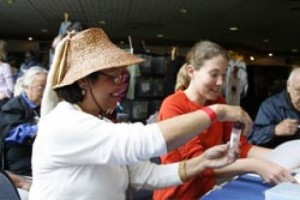
A new genetic-testing effort could provide more information about the connections Tlingits and Haidas have with other tribal groups. A University of Pennsylvania expert is in Southeast to collect DNA samples. He’s hoping for cooperation from those attending this week’s Celebration 2012 cultural festival in Juneau.
The effort is part of a larger project analyzing the genetics of indigenous North American groups.
Principal Investigator Theodore Schurr says it could ultimately map out human migration routes, as well as link tribes.
“So we’re slowly being able to put together … data to see the more deeper history questions, the connections between communities here with those across all of North American on the broader and deeper scale. But also some of these more regional or even tribally based questions which I think are already understood or are being examined through linguistic studies, historical studies and also oral histories and the work being done by the tribes themselves,” Schurr says.
Schurr will be at Juneau’s Centennial Hall during Celebration 2012, which runs Thursday through Saturday. He’s working with the Sealaska Heritage Institute, which organizes the event.
No one is required to participate. Those interested will have the insides of their cheeks swabbed to provide DNA samples. Those will be analyzed, and what’s learned will be shared with the volunteer. The information will also contribute to the larger research project.
A similar genetic testing effort was conducted in 2008 by Washington State University. Schurr says this project will examine additional elements.
“We are taking, I think, the same approach as the earlier study, although analyzing perhaps a number more markers for the maternal lineages and the paternal lineages,” Schurr says.
DNA samples have already been collected in Yakutat and Hydaburg. The effort at Celebration will reach people from many other communities.
Schurr hopes to expand the effort to other villages. But he’s collecting more than cheek swabs.
“Ultimately DNA evidence will tell you a lot about genetic lineages. But why people bear certain genetic lineages has to have some sort of context for interpreting that,” he says.
Those providing DNA samples will also be interviewed about their genealogy. Schurr says that, and other information, will allow for a higher level of analysis.
“It makes a big difference to have geological evidence, oral history information, the archeology or so forth. Because that tells us something about the context in which people have come to live in a place sometime, who they’ve come into contact with, and how far and wide they might have dispersed because of environmental factors (such as) glaciers, or volcanoes, or things of this sort. And how in fact the diversity we see in certain places may be linked with the languages they speak,” he says.
Work done so far has shown some differences between members of the Eagle and Raven moieties.
Sealaska Heritage Institute President Rosita Worl, an anthropologist, has suggested the two groups were once members of different populations.
“I saw an earlier paper that he did where he begins to see that there is a difference and he was working with limited groups of people. But I think this will give him a larger population level to look at. I’m very hopeful,” Worl says.
She says the institute examined Schurr’s project carefully before agreeing to participate.
“I wanted to make sure that there would be no commercial use, that it would be for the specific purpose of this study. And if they were going to use it for other studies, they would have seek the permission of the donor and if the donor should die, that his or her heirs would make that decision,” she says.
Results should be available this year. Schurr says volunteers will find out about their individual data before group information is made public.
